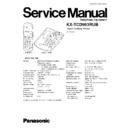Panasonic KX-TCD953RUB (serv.man2) Service Manual ▷ View online
7 BLOCK DIAGRAM RF UNIT (HANDSET)
KX
-T
CD9
53RU
B
21
8 BLOCK DIAGRAM BASE-BAND SECTION (HANDSET)
KX
-T
CD9
53RU
B
22
9 CIRCUIT OPERATION (HANDSET)
9.1. THE BASE-BAND SECTION (SEE BLOCK DIAGRAM Fig. 25)
9.1.1. INTRODUCTION
The base-band section consists of a base-band integrated circuit (BBIC), a Flash PROM, an EEPROM, an LCD Display, a
Microphone, an Earpiece, and power supply/battery management circuits.
Microphone, an Earpiece, and power supply/battery management circuits.
9.1.2. THE BASE-BAND INTEGRATED CIRCUIT (BBIC)
The National SC14405 BBIC (IC1) is a CMOS device designed to handle all the audio, signal and data processing needed in a
DECT handset. It contains two microprocessors - one general purpose - while the other burst mode controller takes care of DECT
specific physical layer and radio section control.The BBIC also contains the ADPCM transcoders, a low power 14 bit codec
(ADC/DAC), various other ADCs, DACs and timers, a UART for data communication with RF unit, a gaussian filter for the DECT
GFSK modulation method, clock and data recovery circuits, a clock oscillator circuit, a battery management circuit, and a pair of
gaincontrollable amplifiers for the microphone and earpiece.
DECT handset. It contains two microprocessors - one general purpose - while the other burst mode controller takes care of DECT
specific physical layer and radio section control.The BBIC also contains the ADPCM transcoders, a low power 14 bit codec
(ADC/DAC), various other ADCs, DACs and timers, a UART for data communication with RF unit, a gaussian filter for the DECT
GFSK modulation method, clock and data recovery circuits, a clock oscillator circuit, a battery management circuit, and a pair of
gaincontrollable amplifiers for the microphone and earpiece.
9.1.3. LCD DISPLAY, AND DISPLAY DRIVER (SEE Fig. 26)
The LCD display also receives data via a serial interface. Serial data is sent to LCD display on pin 3 (TP70). The RS signal (pin
1, TP67) is used by the BBIC to send either commands or data.
1, TP67) is used by the BBIC to send either commands or data.
Circuit Diagram
23
KX-TCD953RUB
9.1.4. AUDIO PATH - TX AUDIO (SEE Fig. 27)
Balanced audio from the microphone (TP40 and TP41) enters the BBIC at pins 61 and 63. A balanced bias voltage for the
(“electret” type) microphone is supplied by the BBIC from pins 60 and 64 via R31 and R32. This supply is de-coupled by R22, R27,
C21, C28, and C22. RF de-coupling of the microphone signal is provided by R27, C25, R28, C26, R24, R25, and C20. The
microphone audio signals are coupled to the BBIC via C22 and C23, which provide some high pass filtering.
In the BBIC audio passes through the gain-controlled microphone amplifier, into the ADC part of the codec, where it is sampled and
turned into digital data. The burst mode controller then processes this raw data (called the B-field) performing encryption and
scrambling, adding the various other fields that go together to produce the GAP standard DECT frame, assigning to a time slot and
channel etc. The data then passes through the gaussian filter to emerge on pin 20 as TRADAT.
(“electret” type) microphone is supplied by the BBIC from pins 60 and 64 via R31 and R32. This supply is de-coupled by R22, R27,
C21, C28, and C22. RF de-coupling of the microphone signal is provided by R27, C25, R28, C26, R24, R25, and C20. The
microphone audio signals are coupled to the BBIC via C22 and C23, which provide some high pass filtering.
In the BBIC audio passes through the gain-controlled microphone amplifier, into the ADC part of the codec, where it is sampled and
turned into digital data. The burst mode controller then processes this raw data (called the B-field) performing encryption and
scrambling, adding the various other fields that go together to produce the GAP standard DECT frame, assigning to a time slot and
channel etc. The data then passes through the gaussian filter to emerge on pin 20 as TRADAT.
9.1.5. AUDIO PATH - RX AUDIO (SEE Fig. 27)
Audio from the receiver RECDAT (TP54) enters the BBIC on pin 18 and passes through the clock recovery circuit. The burst mode
controller separates out the B-field data, and performs de-encryption and de-scrambling as required. It then goes to the DAC part
of the codec where data is turned back into analogue audio. The audio signal is amplified by the gain-controlled earpiece amplifier,
and balanced audio is output on pins 65 and 66, and fed to the earpiece (TP31 and TP32). The leads feeding the earpiece are RF
de-coupled by C15 to R22, C17, C16, R23, and C18. C19 provides low pass filtering.
controller separates out the B-field data, and performs de-encryption and de-scrambling as required. It then goes to the DAC part
of the codec where data is turned back into analogue audio. The audio signal is amplified by the gain-controlled earpiece amplifier,
and balanced audio is output on pins 65 and 66, and fed to the earpiece (TP31 and TP32). The leads feeding the earpiece are RF
de-coupled by C15 to R22, C17, C16, R23, and C18. C19 provides low pass filtering.
Circuit Diagram
24
KX-TCD953RUB
Click on the first or last page to see other KX-TCD953RUB (serv.man2) service manuals if exist.

